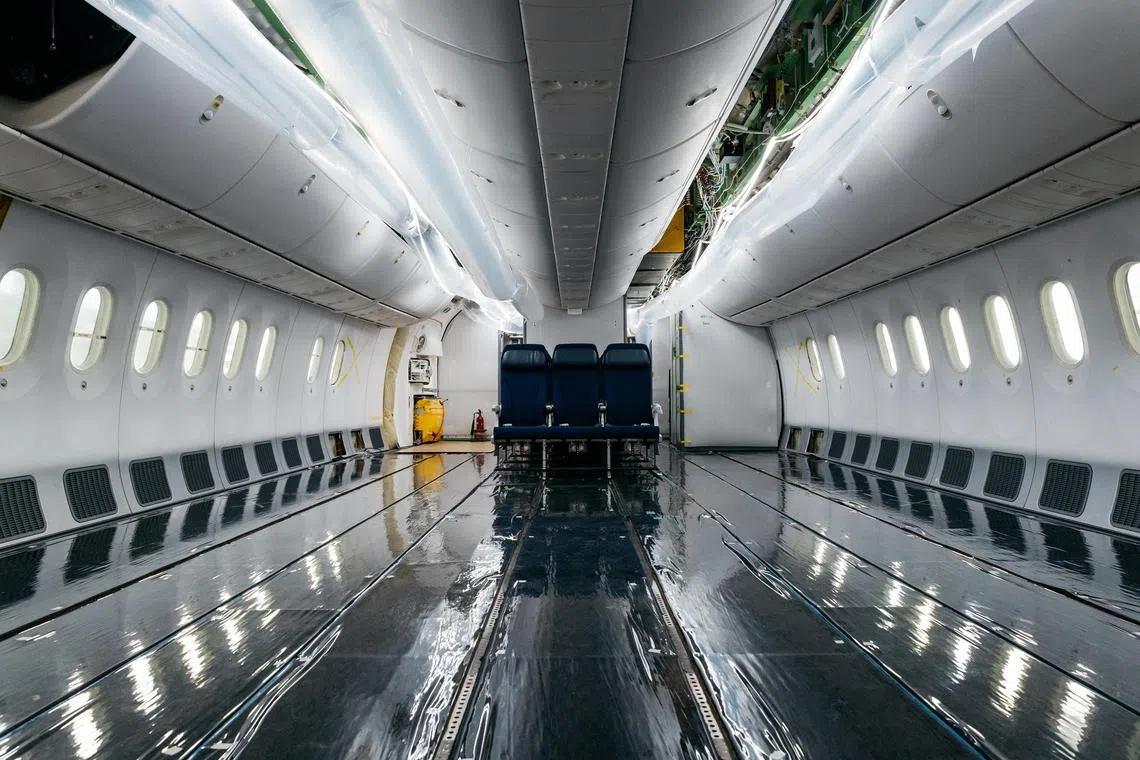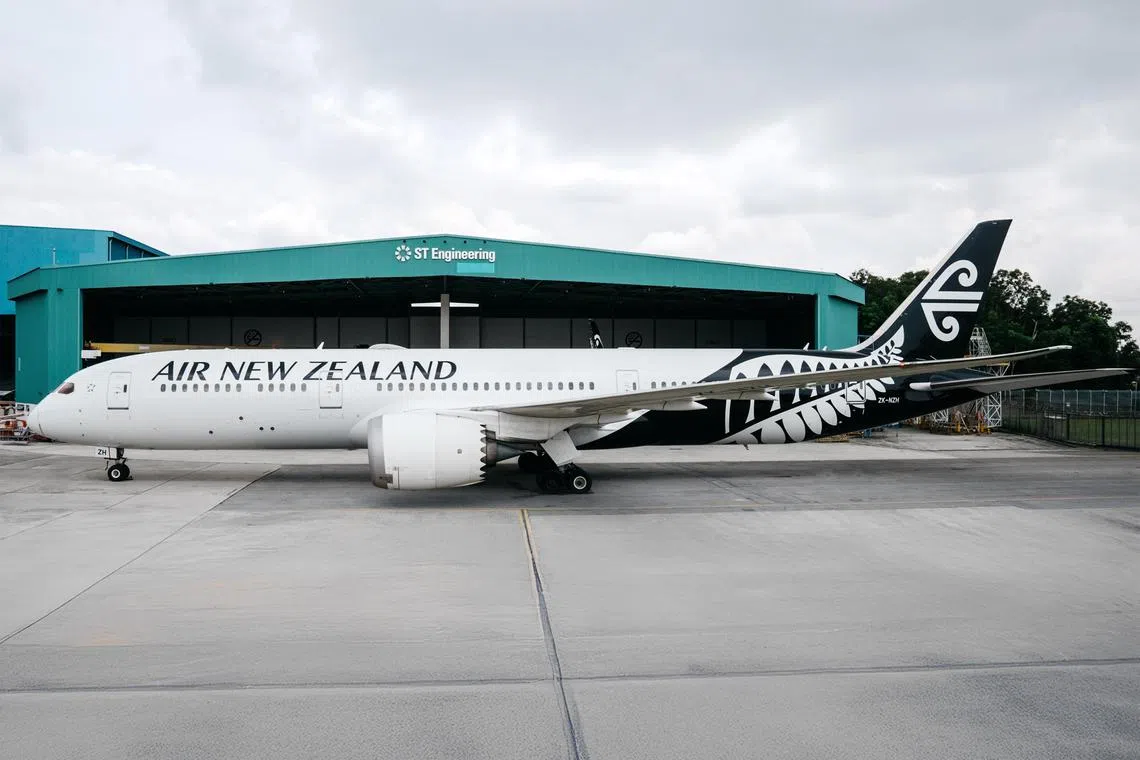ST Engineering retrofits Air NZ’s B787s in world first as airline faces supply chain delays
Sign up now: Get ST's newsletters delivered to your inbox

All 14 of Air New Zealand’s B787-9 aircraft will be retrofitted one at a time at ST Engineering’s airframe facility in Changi.
PHOTO: AIR NEW ZEALAND
Follow topic:
SINGAPORE – Days after the wide-body Boeing 787-9 plane arrived in Singapore from New Zealand, technicians removed its 302 seats, tore out the carpet and dismantled all its ceiling panels and overhead bins, leaving the plane’s interior entirely empty.
This gutting of the Air New Zealand aircraft in October was in preparation for the world’s first nose-to-tail retrofit of a 787-9 Dreamliner, which is being done in Singapore by home-grown technology and engineering group ST Engineering.
All 14 of Air New Zealand’s 787-9 aircraft will be retrofitted one at a time at ST Engineering’s airframe facility in Changi. Seven will be completed by the end of 2025, and the rest by the end of 2026.
Air New Zealand chief executive Greg Foran put the cost of the retrofit programme at NZ$500 million (S$390 million), or about NZ$35 million per aircraft.
The Dreamliners are being retrofitted to install a new in-flight entertainment system with larger screens, revamped seats in every cabin and new carpet throughout the aircraft, among other upgrades.

The Dreamliners are being retrofitted to install a new in-flight entertainment system with larger screens.
PHOTO: AIR NEW ZEALAND
Airlines typically choose to launch new products – such as redesigned seats – on new aircraft.
However, Air New Zealand has been facing supply chain problems, which have delayed aircraft deliveries and grounded existing ones.
With the airline becoming “increasingly concerned” about when its new aircraft would be delivered, Mr Foran said Air New Zealand opted to take the unconventional approach of putting its new offerings on older planes.
The decision was made for the airline to “come up with a new product, get it certified, and then put it on a retrofit plane”, Mr Foran told The Straits Times during a visit to the airframe facility on Dec 2.
“That way, our customers will get to experience something new, instead of having to wait for a new plane.”

The newly-installed economy seats.
PHOTO: AIR NEW ZEALAND
Mr Foran said Air New Zealand had planned to retrofit its 787-9 planes “since a couple of years before the Covid-19 pandemic”, but the pandemic and subsequent supply chain issues scuppered these plans.
Mr Yip Hin Meng, executive vice-president for aerospace MRO (maintenance, repair and overhaul) at ST Engineering, said the group has worked with Air New Zealand since 2015 and is the airline’s heavy maintenance partner.
The first retrofit is being done in conjunction with heavy maintenance checks, ST Engineering said.
Work on the first 787-9 plane began in October, about two months behind schedule due to the late arrival of parts.
Retrofitting a plane is akin to “renovating a house to give its interior a complete makeover”, a spokesman for ST Engineering explained.
The aircraft is first stripped of its interior and some loose equipment, including wiring. It is then fitted with the new products according to the airline’s specifications.
Toilets and galleys – or aircraft kitchens – may be repositioned, while existing water and waste lines, and the wiring for seats and in-flight entertainment systems, will also be modified.
The carpets, seats and overhead bins and ceiling panels are then installed and tested.

The aircraft is first stripped of its interior and some loose equipment, including wiring. It is then fitted with the new products according to the airline’s specifications.
PHOTO: AIR NEW ZEALAND
Upon completion of the prototype plane – the first to be retrofitted – applications will be submitted for supplemental type certificates from aircraft maker Boeing, the US Federal Aviation Administration (FAA), the Civil Aviation Authority of Singapore and the Civil Aviation Authority of New Zealand. A supplemental type certificate is issued when an applicant has received FAA approval to modify an aeronautical product – such as a plane – from its original design.
The first retrofit will be completed in January, and the aircraft will return to operating its usual routes from mid-February.
An Air New Zealand spokesperson said all 14 retrofitted aircraft “will fly anywhere they currently do”, such as between Auckland and Vancouver.

The first Boeing 787-9 (ZK-NZH) to undergo a nose-to-tail retrofit arrived in Singapore in October 2024.
PHOTO: AIR NEW ZEALAND
It takes a 40-person team between 30 and 35 days to retrofit one aircraft, ST Engineering said, though there are hundreds more people – mechanics, technicians and engineers – behind the scenes on the project.
The prototype aircraft usually poses more challenges due to “design complexities and certification” requirements, ST Engineering said. Subsequent retrofits will get easier after these initial challenges are resolved, it added.
Air New Zealand’s planes will be reconfigured as part of the retrofit, and will have 272 seats across four classes, including a new business premier luxe class, a notch up from business class that will give customers more privacy with a fully closing door and space for two to dine.
ST Engineering has been retrofitting passenger jets since the 1990s. It previously conducted partial retrofit work for Air New Zealand’s Boeing 777 aircraft in 2017, and has also done retrofitting for Air Canada and Japan Airlines.

It takes a 40-person team between 30 and 35 days to retrofit one aircraft, ST Engineering said.
PHOTO: AIR NEW ZEALAND


